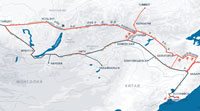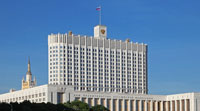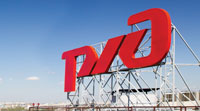Primary principles of the risk management system
- a comprehensive and systematic approach to performing risk management procedures based on the accounting of the systematic correlation of risks, the nature of their mutual influence and the possible implications from their cumulative materialisation;
- strategic focus of risk management activities based on a direct correlation with the strategic goals and development areas of the Russian Railways Group specified by the
- Russian Railways Group’s Development Strategy until 2030 and the integration of risk monitoring processes with the strategic planning system;
- continuity of the risk management process based on monitoring and regular updating of the information used in the corporate risk management system;
- unity of risk management based on developing coordinated and coherent approaches to the adoption of
- management decisions to prevent or minimise risks at all management levels of the Russian Railways Group;
- the introduction of risk management procedures in all functional areas of the Russian Railways Group’s activities;
- ensuring the appropriate distribution of powers and responsibilities when adopting management decisions.
The Russian Railways Group’s corporate risk management system includes four interrelated stages that are implemented based on an inverse relationship
- Identification and qualitative analysis
- Assessment and quantitative analysis
- Selection of risk treatment method
- Monitoring of treatment efficiency
The Regulation on Internal Audits at the Russian Railways Group, and the Regulation on the Zheldoraudit Internal Audit Centre which was approved by Russian Railways President Vladimir Yakunin, assign the latter the task and function of assessing the effectiveness of the internal control and risk management systems as well as providing Russian Railways management with reliable information about financial and business activities, the efficiency of business processes and the reliability of internal control and risk management procedures within the subdivisions of Russian Railways in a timely manner.
In accordance with the recommendations of the Corporate Governance Code approved by the Russian Central Bank’s Board of Directors on 21 March 2014 on the establishment of a separate structural division for risk management at the Company or a legal entity that performs the functions of such a division, the action plan for the introduction of the basic provisions of the Company’s Corporate Governance Code (approved at a meeting of the Russian Railways Board of Directors) envisages the establishment of a risk management project office whose main objective will be to organise the risk management system at Russian Railways.
Risk treatment measures
- Risk prevention involves neutralising the sources of such risk and is most effective with respect to the internal risks of the Russian Railways Group.
- Mitigating damage from risks involves developing measures to minimise losses if risks materialise and above all aims to manage the external risks of the Russian Railways Group.
- The decision is made to retain risks and not enact counteracting management decisions in cases when the cost of neutralising the risk is much greater compared with the damage from its materialisation.
The optimal form of risk treatment (risk prevention, mitigating damage from risks or retaining risks) is selected based on a comparative assessment of the effectiveness of each option.
Risk map of the Russian Railways Group
Risk category |
Risks |
Macroeconomic |
- reduction in the volume of freight provided for transportation;
- risk of unplanned fluctuations in transportation volumes exceeding the carrying capacity of certain railway sections;
- deterioration in the structure of industrial and agricultural production;
- growth in prices for goods and services consumed by the Russian Railways Group as a result of inflation;
- decrease in the Company’s income from passenger transportation due to a decline in the public’s ability to pay;
- decline in investment and business activity.
|
Market |
- decrease in the Russian Railways Group’s share of highly profitable segments of the transportation market;
- growth in intra-industry and cross-industry competition;
- advanced development of alternative types of transportation, including through the accelerated introduction of innovations;
- establishment and full-scale operation of international corridors to bypass Russia;
- risk of the quality and range of services not complying with new customer requirements;
- lack of production capacity among product suppliers for the Russian Railways Group.
|
Financial |
- credit risks;
- currency risks;
- interest risks;
- price risks as regards raw commodity and energy assets;
- risk of liquidity loss;
- downgrading of Russian Railways positions by international ratings agencies;
- financial implications from property and liability risks.
|
Human resource risks |
- increased imbalances in the structure of the workforce represented on the market;
- deterioration in the positions of Russian Railways on the labour market;
- deterioration in the quality of the workforce;
- reduction in the working population in remote regions due to the urbanisation of society;
- risk of the diminished attractiveness of professions in the railway transportation industry.
|
Regulatory risks |
- continued strict government tariff regulation;
- stricter environmental requirements;
- stricter legislation (transportation, tax, etc.);
- failure to fulfil the action plan to give the constituent entities of the Russian Federation greater responsibility for the compensation of falling income by suburban passenger companies.
|
Political |
- impact of international sanctions against the country’s economy and activities of Russian Railways;
- deterioration in intergovernmental relations;
- local military operations.
|
Manmade, natural and climatic |
- accidents at facilities that support the work of the Russian Railways Group;
- manmade accidents on related types of transportation (primarily in seaport waters and on major highways);
- fires or natural disasters in areas where the Russian Railways Group operates.
|
Scientific, technical and technological |
- use of new energy resources and energy-saving modes on alternative types of transportation;
- improving the carrying capacity of vehicles and vessels.
|
Risk category |
Risks |
Production and technological |
- lag in infrastructure development compared with the increase in freight and passenger transportation;
- disruptions in the organisation of freight delivery logistics schemes;
- disruptions to the plan for making up trains and the train traffic schedule;
- violations of traffic safety;
- diminished efficiency from the use of rolling stock;
- discrepancy in existing technological processes for organising transportation with the quality requirements for transportation products.
|
Technical and resource |
- continued high level of fixed asset deterioration;
- breach of the deadlines and conditions for supplies of material resources;
- risk of using substandard and incomplete information about consumers of the Russian Railways Group’s services.
|
Investment |
- incorrect substantiation and erroneous selection of new investment targets;
- diminished return on investment and failure to ensure planned profitability from invested funds;
- lack of clear guarantees for transportation volume from freight owners when implementing infrastructure investment projects;
- risk of the failure to meet the parameters of the projects implemented (exceeding the budget, failure to meet deadlines or failure to achieve the project objective).
|
Risks of structural reforms |
- threat of a disruption to the technological processes of the Russian Railways Group and significant financial losses as a result;
- threat of the loss of financial sustainability and the risk of bankruptcy of S&A;
- decrease in the profitability of the Russian Railways Group due to the uncompensated spin-off of highly profitable S&A;
- decline in asset value and capitalisation of the Russian Railways Group in the event of the ineffective work of S&A.
|
Personnel |
- lack of compliance of the professional level of personnel with the requirements of the Russian Railways Group;
- risk of a further increase in the number of employees approaching retirement age;
- outflow of highly skilled personnel due to insufficient motivation and the decreased competitiveness of salaries for employees of the Russian Railways Group compared with other industries;
- violations of labour safety through the fault of personnel;
- risk of ineffective recruiting, placement and management of personnel;
- violations of labour discipline;
- deterioration in the corporate culture of employees.
|
Management |
- reduced manageability of Russian Railways Group structures;
- adoption of unsubstantiated management decisions;
- failure to execute decisions by the required deadlines;
- failure to achieve target economic and production performance results of the Russian Railways Group.
|









